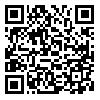BibTeX | RIS | EndNote | Medlars | ProCite | Reference Manager | RefWorks
Send citation to:
URL: http://aums.abzums.ac.ir/article-1-1796-en.html
2- Department of Internal Medicine, Fasa University of Medical Sciense, Fasa, Iran ,
3- Yazd Medical Science Branch, Islamic Azad University, Yazd, Iran
Introduction: Obstructive sleep apnea (OSA) is a common sleep disorder associated with cardiovascular and cerebrovascular diseases and metabolic disorders. The aim of the present study was to investigate the diagnostic value of combining the Stop-Bang and ESS questionnaires with pulse oximetry in diagnosing OSA compared to polysomnography (PSG).
Methods: This is a descriptive, analytical, and cross-sectional study. People who visit the hospital for a sleep test completed the STOP-BANG and ESS questionnaires before the test. Then, the results of the questionnaires, which are the sum of the scores of each questionnaire, and the results of pulse oximetry, which include hypoxia and the AHI and ODI indices, were compared with the results of PSG.
Results: In this study, it was shown that there is a good agreement between SPO2 and PSG, STOP-BANG and PSG, ESScod and PSG, based on the Kappa test. The sensitivity of the STOP-BANG questionnaire was higher than the ESS questionnaire with pulse oximetry in diagnosing OSA compared to PSG, and the sensitivity of the combined questionnaire was higher than the ESS questionnaire with pulse oximetry in diagnosing OSA compared to PSG.
Conclusion: Based on the findings, the combination of the studied questionnaires has more added value.
Received: 2024/03/10 | Accepted: 2025/03/01 | Published: 2025/03/03
| Rights and permissions | |
 |
This work is licensed under a Creative Commons Attribution-NonCommercial 4.0 International License. |







